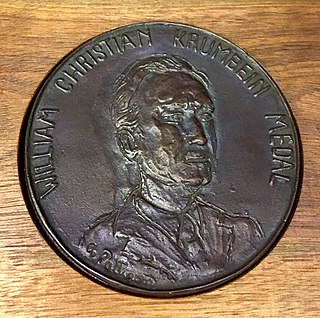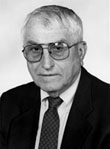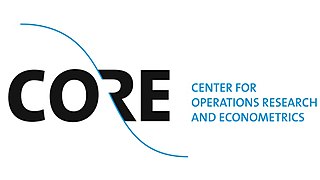Geostatistics is a branch of statistics focusing on spatial or spatiotemporal datasets. Developed originally to predict probability distributions of ore grades for mining operations, it is currently applied in diverse disciplines including petroleum geology, hydrogeology, hydrology, meteorology, oceanography, geochemistry, geometallurgy, geography, forestry, environmental control, landscape ecology, soil science, and agriculture. Geostatistics is applied in varied branches of geography, particularly those involving the spread of diseases (epidemiology), the practice of commerce and military planning (logistics), and the development of efficient spatial networks. Geostatistical algorithms are incorporated in many places, including geographic information systems (GIS).

Geologic modelling,geological modelling or geomodelling is the applied science of creating computerized representations of portions of the Earth's crust based on geophysical and geological observations made on and below the Earth surface. A geomodel is the numerical equivalent of a three-dimensional geological map complemented by a description of physical quantities in the domain of interest. Geomodelling is related to the concept of Shared Earth Model; which is a multidisciplinary, interoperable and updatable knowledge base about the subsurface.

Ole Eiler Barndorff-Nielsen was a Danish statistician who has contributed to many areas of statistical science.
Science and technology in Flanders, being the Flemish Community and more specifically the northern region of Belgium (Europe), is well developed with the presence of several universities and research institutes. These are strongly spread over all Flemish cities, from Kortrijk and Bruges in the Western side, over Ghent as a major university center alongside Antwerp, Brussels and Leuven to Hasselt and Diepenbeek in the Eastern side.
Patrick Callaerts is a Belgian molecular biologist and researcher at the Katholieke Universiteit Leuven. He is head of the VIB Laboratory of Developmental Genetics, KU Leuven.
Willy Geysen is the head of the Centre for Intellectual Property Rights (CIR) at the Katholieke Universiteit Leuven and was President of Caritas Catholica Flanders from 1996 until 2008, when he was succeeded by Guido Van Oevelen.
In geophysics, seismic inversion is the process of transforming seismic reflection data into a quantitative rock-property description of a reservoir. Seismic inversion may be pre- or post-stack, deterministic, random or geostatistical; it typically includes other reservoir measurements such as well logs and cores.
Mark Jozef Albert, Baron Waer is a Belgian physician, biomedical scientist, and former Rector of the Katholieke Universiteit Leuven.
Derrick-Philippe B. J., Baron Gosselin (1956) is a Belgian engineer and economist. He is chairman of the Belgian Nuclear Sciences Research Center SCK CEN, vice-chairman of Belgonucleaire and vice-chairman of the Royal Higher Institute for Defence (RHID). He is on the board of the Von Karman Institute.

KU Leuven is a Catholic research university in the city of Leuven, Belgium, founded in 1834 in Mechelen by the catholic bishops of Belgium "to welcome any doctrine emanating from the Holy Apostolic See and to repudiate everything that did not flow from this august source".

The William Christian Krumbein Medal is the highest award given alternate years by the International Association for Mathematical Geosciences (IAMG) to senior scientists for career achievement, which includes (a) distinction in application of mathematics or informatics in the earth sciences, (b) service to the IAMG, and (c) support to professions involved in the earth sciences. There is no stipulated preference for fields of application within the earth sciences. The William Christian Krumbein Medal, named after William Christian Krumbein, was established in 1976.

John Warvelle Harbaugh (1926-2019) was an American geologist who spent most of his professional career at Stanford University devoted to research on mathematical modeling of dynamic systems, sedimentary basin simulation and oil exploration risk analysis. Since 1999, he was Professor Emeritus both at the Geological and Environmental Sciences Department and at the Energy Resources Engineering Department.

Vera Pawlowsky-Glahn is a Spanish-German mathematician. From 2000 till 2018, she was a full-time professor at the University of Girona, Spain in the Department of Computer Science, Applied Mathematics, and Statistics. Since 2018 she is emeritus professor at the same university. She was previously an associate professor at Technology University in Barcelona from 1986 to 2000. Her main areas of research interest include statistical analysis of compositional data, algebraic-geometric approach to statistical inference, and spatial cluster analysis. She was the president of the International Association for Mathematical Geosciences (IAMG) during 2008–2012. IAMG awarded her the William Christian Krumbein Medal in 2006 and the John Cedric Griffiths Teaching Award in 2008. In 2007, she was selected IAMG Distinguished Lecturer.
During the 6th International Workshop on Compositional Data Analysis in June 2015, Vera was appointed president of a commission to formalize the creation of an international organization of scientists interested in the advancement and application of compositional data modeling.

Ricardo Antonio Olea is a Chilean American who was a research mathematical statistician with the United States Geological Survey (2006–21). Previously, he spent most of his career with the National Oil Company of Chile (ENAP) in Punta Arenas and Santiago, and with the Kansas Geological Survey in Lawrence. He received the William Christian Krumbein Medal in 2004 from the International Association for Mathematical Geosciences. He served as Secretary-General (1992−1996) and President (1996–2000) for the International Association for Mathematical Geosciences; and Secretary General (2019–21) of the Compositional Data Association.
Daniel Francis Merriam was an American geologist best known for fostering the development of quantitative modeling in geology after the advent of digital computers. He first joined the Kansas Geological Survey in 1953, initially working under the direction Raymond C. Moore to have a more accurate knowledge about the geology of the state. His fascination with the new possibilities offered by computers started ten years later while working with John W. Harbaugh at Stanford University as Visiting Research Scientist. In the following seven years, he was active organizing colloquia and as editor of the Computer Contributions, who saw 50 publications in the series by pioneers in the new field. Merriam accepted the position of Chairman of the Department of Geology at Syracuse University in 1971 and moved to the same position at Wichita State University in 1981, coming back to the Kansas Geological Survey in 1991 to retire in 1997, remaining as an Emeritus Scientist.
André Georges Journel is a French American engineer who excelled in formulating and promoting geostatistics in the earth sciences and engineering, first from the Centre of Mathematical Morphology in Fontainebleau, France and later from Stanford University.

The Center for Operations Research and Econometrics (CORE) is an interdisciplinary research institute of the University of Louvain (UCLouvain) located in Louvain-la-Neuve, Belgium. Since 2010, it is part of the Louvain Institute of Data Analysis and Modeling in economics and statistics (LIDAM), along with the Institute for Economic and Social Research (IRES), Louvain Finance (LFIN) and the Institute of Statistics, Biostatistics and Actuarial Sciences (ISBA).
Basanta Kumar Sahu is an Indian mathematical geologist, sedimentologist and a Professor Emeritus at the Indian Institute of Technology, Bombay. He is for known for his mathematical and quantitative studies in geology and the development of statistical and mathematical models. A founder member of the founded the International Association of Mathematical Geologists, he is a member of the American Association of Petroleum Geologists and the Society of Economic Paleontologists and Mineralogists. The Council of Scientific and Industrial Research, the apex agency of the Government of India for scientific research, awarded him the Shanti Swarup Bhatnagar Prize for Science and Technology, one of the highest Indian science awards for his contributions to Earth, Atmosphere, Ocean and Planetary Sciences in 1980.
Noble Banadda was a Ugandan biosystems engineer, researcher and academic, who was a professor of biosystems engineering at Makerere University, Uganda's largest and oldest public university. He was appointed a full professor in 2012 at age 37, one of the youngest persons in the history of the university to attain full professorship.

J. Jaime Gómez-Hernández is a Spanish civil engineer specialized in geostatistics and hydrogeology. He is a full professor of hydraulic engineering at the School of Civil Engineering of the Technical University of Valencia. He was conferred the William Christian Krumbein Medal in 2020 from the International Association for Mathematical Geosciences. He also received the 2020 Prince Sultan bin Abdulaziz International Prize for Water in the field of groundwater.









